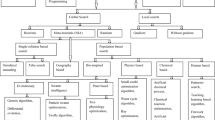Abstract
The artificial bee colony (ABC) algorithm is improved to construct a hybrid multi-objective ABC algorithm, called HMOABC, for resolving optimal power flow (OPF) problem by simultaneously optimizing three conflicting objectives of OPF, instead of transforming multi-objective functions into a single objective function. The main idea of HMOABC is to extend original ABC algorithm to multi-objective and cooperative mode by combining the Pareto dominance and divide-and-conquer approach. HMOABC is then used in the 30-bus IEEE test system for solving the OPF problem considering the cost, loss, and emission impacts. The simulation results show that the HMOABC is superior to other algorithms in terms of optimization accuracy and computation robustness.
Similar content being viewed by others
References
HABIABOLLAHZADEH H, LUO G, SEMLYEN A. Hydrothermal optimal power flow based on combined linear and nonlinear programming methodology [J]. IEEE Transactions on Power Systems, 1989, 4(2): 530–537.
AJAMI A, ARMAGHAN M. A multi-objective gravitational search algorithm based approach of power system stability enhancement with UPFC [J]. Journal of Central South University, 2013, 6: 1536–1544.
BAKIRTZIS A G, BISKAS P N, ZOUMAS C E, PETRIDIS V. Optimal power flow by enhanced genetic algorithm [J]. IEEE Transactions on Power Systems, 2002, 17: 229–236.
SOUSA T, SOARES J, VALE Z A, MORAIS H, FARIA P. Simulated annealing metaheuristic to solve the optimal power flow [C]// IEEE Power and Energy Society General Meeting. 2011: 1–8.
ABIDO M A. Optimal power flow using tabu search algorithm [J]. Electric Power Components and Systems, 2002, 30: 469–483.
SAYAH S, ZEHAR K. Modified differential evolution algorithm for optimal power flow with non-smooth cost functions [J]. Energy Conversion and Management, 2008, 49: 3036–3042.
SIVASUBRAMANI S, SWARUP K S. Multi-objective harmony search algorithm for optimal power flow problem [J]. Electrical Power and Energy Systems, 2011, 33: 745–752.
ROY P K, GHOSHAL S P, THAKUR S S. Biogeography based optimization for multiconstraint optimal power flow with emission and non-smooth cost function [J]. Expert Systems with Applications, 2010, 37: 8221–8228.
EBERCHART R C, KENNEDY J. A new optimizer using particle swarm theory [C]// Proceeding of the 6th International Symposium on Micromachine and Human Science. Nagoya, Japan, 1995: 39–43.
MA Lian-bo, HU Kun-yuan, ZHU Yun-long, CHEN Han-ning. Computational evolution of social behavior in bacterial colony optimization model [J]. Journal of Pure and Applied Microbiology, 2013, 7: 487–493.
KARABOGA D, AKAY B. A comparative study of artificial bee colony algorithm [J]. Applied Mathematics and Computation, 2009, 214: 108–132.
ZHOU Wen-ping, ZHU Yun-long, CHEN Han-ning. Solving multi-objective optimization problems using artificial bee colony algorithm [J]. Discrete Dynamics in Nature and Society, 2011:569784–569784.
HEDAYATZADEH R, HASANIZADEH B, AKBARI R, ZIARATI K. A multi-objective artificial bee colony for optimizing multi-objective problems [C]// 3rd International Conference on Advanced Computer Theory and Engineering (ICACTE). Chengdu, China, 2010: 277–281.
DEB K, PRATAP A, AGARWAL S, MEYARIVAN T. A fast and elitist multiobjective genetic algorithm: NSGA-II [J]. IEEE Trans Evol Comput, 2002, 6(2): 182–197.
ZITZLER E, LAUMANNS M, THIELE L. SPEA2: Improving the strength pareto evolutionary algorithm [C]// Proc EUROGEN 2001: Evolutionary Methods Design Optimization Control Appl Ind Problems. Athens, Greece, 2002: 95–100.
CARLOS A, PULIDO G T, MAXIMINO S L. Handling multiple objectives with particle swarm optimization [J]. IEEE Transactions on Evolutionary Computation, 2004, 8(3): 256–279.
WALTERS D C, SHEBLE G B. Genetic algorithm solution of economic dispatch with valve point loading [J]. IEEE Transactions on Power Systems, 1993, 8: 1325–1332.
POTTER M A, de JONG K A. Cooperative coevolution: An architecture for evolving coadapted subcomponents [J]. Evolutionary Computation, 2000, 8: 1–29.
YE Bin, ZHANG Peng-xiang, ZHAO Bo, CAO Yi-jia. Multiobjective hybrid evolutionary algorithm for economic load dispatch [J]. Proceeding of the CSU-EPSA, 2007, 19(2): 67–72. (in Chinese)
ALSAC O, STOTT B. Optimal load flow with steady-state security [J]. IEEE Trans. Power Appar Syst, 1974, 93(3): 745–751.
Author information
Authors and Affiliations
Corresponding author
Additional information
Foundation item: Projects(61105067, 61174164) supported by the National Natural Science Foundation of China
Rights and permissions
About this article
Cite this article
Ma, Lb., Hu, Ky., Zhu, Yl. et al. Improved multi-objective artificial bee colony algorithm for optimal power flow problem. J. Cent. South Univ. 21, 4220–4227 (2014). https://doi.org/10.1007/s11771-014-2418-1
Received:
Accepted:
Published:
Issue Date:
DOI: https://doi.org/10.1007/s11771-014-2418-1




